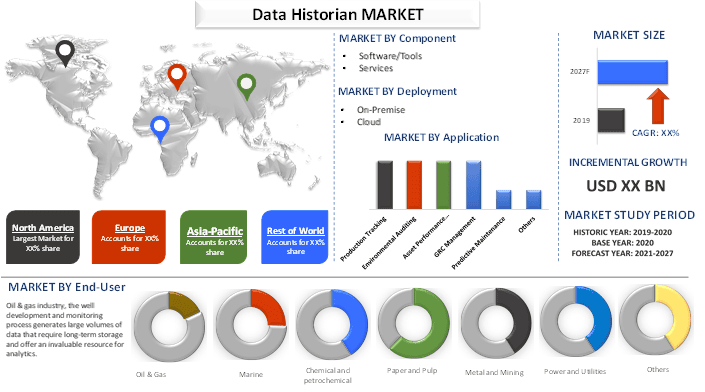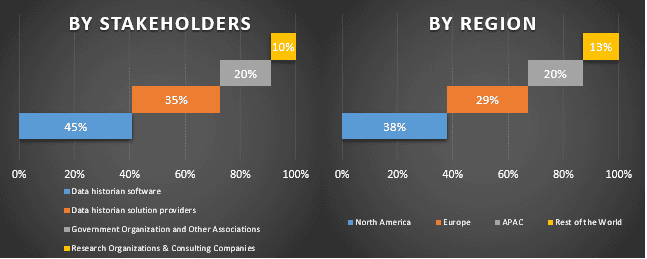- Home
- About Us
- Industry
- Services
- Reading
- Contact Us
Data Historian Market: Current Analysis and Forecast (2019-2027)
Emphasis on Components (Software/tools, Service); Application (Production Tracking, Environmental Auditing, Asset Performance Management, GRC Management, Predictive Maintenance and others), Deployment Mode (On-premises and Cloud), Organization Size (SMEs and Large enterprises), End-Use (Oil and Gas, Marine, Chemicals and Petrochemicals, Paper and Pulp, Metal and Mining, Power and Utilities and Others), and Region and Country

Global Data Historian Market is expected to exceed the market valuation of more than US$1.5 million by 2027, demonstrating significant CAGR of around 5.4% during the forecast period (2021-2027). Increasing focus on ongoing and upcoming trends such as digitization, IoT and Industry 4.0 coupled with the rising number of automotive manufacturing plants and rapid urbanization in the region is driving the growth of the Data Historian market. In addition, rising volumes of big industrial data coupled with increasing demand for consolidated data for process and performance improvement are major factors expected to drive the growth. In addition, with the advent of Industry 4.0, smart factories, and smart plants, organizations worldwide are demonstrating a shift to the usage of massive amounts of data at several layers of their process.
The outbreak of COVID-19 in 2020 had impacted on all the elements of the technology sector. The global ICT spending is estimated to decline by 4%–5% by the end of 2020. The hardware business is predicted to have the most impact on the IT industry. Due to the slowdown of hardware supply and reduced manufacturing capacity, the IT infrastructure growth has slowed down. Hence, businesses providing solutions and services had seen slump in the growth rate for a short span of time. However, the adoption of collaborative applications, analytics, security solutions, and AI has increase in the remaining part of the year.
Different Types of Data Historian Components, 2020

GE, ABB, Emerson, Siemens, AVEVA, Honeywell, Rockwell Automation, OSIsoft, ICONICS, IBM, Yokogawa, PTC, Inductive Automation, Canary Labs, Open Automation Software are some of the prominent players operating in the Global Data Historian Market. Several M&As along with partnerships have been undertaken by these players to facilitate customers with hi-tech and innovative products/technologies.
Insights Presented in the Report
“Amongst Component, Software segment holds the major share”
Based on components, the market is classified into Software and services. The software segment generated largest market share in 2020 because data historian software has led to process improvement and therefore the demand for such software has surged in the market.
“Amongst application, Assets Performance Management Segment holds the major share”
Based on application, the market is segmented into less than Production Tracking, Environmental Auditing, Asset Performance Management, GRC Management, Predictive Maintenance and others (security and quality control management). The assets performance management segment grabbed prominent market share of the global Data Historian market in 2020.
“Amongst deployment mode, cloud segment holds the major share”
Based on deployment mode, the market is segmented into on-premises and cloud. In 2020, the cloud segment dominated the Data Historian market. This segment would witness a considerable CAGR during the forecast period owing to surging adoption of cloud deployment in small and medium scale enterprises.
“Amongst organization size, SMEs segment holds the major share”
Based on organization size, the market is classified into SMEs and Large enterprises. The SMEs segment generated revenue significant market revenue in 2020. Also, the segment is expected to grow at a considerable CAGR during the forecast period. However, large scale enterprises segment is expected to gain considerable market presence in forecast period.
“Amongst End-Use, Oil and Gas segment holds the major share”
Based on End-use, the market is segmented into Oil and Gas, Marine, Chemicals and Petrochemicals, Paper and Pulp, Metal and Mining, Power and Utilities and Others In 2020, the oil and gas segment dominated the Data Historian market. The requirement for machine execution monitoring, hefty equipment monitoring, and checking creation status in the oil and gas industry is expanding the interest for data history specialist arrangements.
“Asia Pacific represents one of the largest markets of Global Data Historian Market”
For a better understanding of the market dynamics of the Global Data Historian Market, a detailed analysis was conducted for different regions including Asia Pacific, North America, Europe and Rest of the World. Asia Pacific constitutes the largest market for the industry in 2020 predominantly because of rapid urbanization and economic development.
Reasons to buy this report:
- The study includes market sizing and forecasting analysis validated by authenticated key industry experts
- The report presents a quick review of overall industry performance at one glance
- The report covers an in-depth analysis of prominent industry peers with a primary focus on key business financials, product portfolio, expansion strategies, and recent developments
- Detailed examination of drivers, restraints, key trends, and opportunities prevailing in the industry
- The study comprehensively covers the market across different segments
- Deep dive regional level analysis of the industry
Customization Options:
Global Data Historian Market can further be customized as per the requirement or any other market segment. Besides this, UMI understands that you may have your own business needs, hence feel free to connect with us to get a report that completely suits your requirements.
Table of Content
Analyzing the historical market, estimation of the current market, and forecasting the future market of the global Data Historian market were the three major steps undertaken to create and analyze the adoption of data historian system in major regions globally. Exhaustive secondary research was conducted to collect the historical market numbers and estimate the current market size. Secondly, to validate these insights, numerous findings, and assumptions were taken into consideration. Moreover, exhaustive primary interviews were also conducted, with industry experts across the value chain of the global Data Historian Market. Post assumption and validation of market numbers through primary interviews, we employed a top-down/bottom-up approach to forecasting the complete market size. Thereafter, market breakdown and data triangulation methods were adopted to estimate and analyze the market size of segments and sub-segments the industry pertains to. Detailed methodology is explained below:
Analysis of Historical Market Size
Step 1: In-Depth Study of Secondary Sources:
Detail secondary study was conducted to obtain the historical market size of the Global Data Historian Market through company internal sources such as annual report & financial statements, performance presentations, press releases, etc., and external sources including journals, news & articles, government publications, competitor publications, sector reports, third-party database, and other credible publications.
Step 2: Market Segmentation:
After obtaining the historical market size of the Global Data Historian Market, we conducted a detailed secondary analysis to gather historical market insights and share for different segments & sub-segments for major regions. Major segments included in the report as components, application, deployment mode, organization size, end-use. Further country-level analyses were conducted to evaluate the overall adoption of testing models in that region.
Step 3: Factor Analysis:
After acquiring the historical market size of different segments and sub-segments, we conducted a detailed factor analysis to estimate the current market size of global Data Historian market. Further, we conducted factor analysis using dependent and independent variables such as increasing deployment type of data historian and increasing adoption of different type of data historian material. A thorough analysis was conducted for demand and supply-side scenarios considering top partnerships, merger and acquisition, business expansion, and product launches in the global data historian market sector across the globe.
Current Market Size Estimate & Forecast
Current Market Sizing: Based on actionable insights from the above 3 steps, we arrived at the current market size, key players in the Global Data Historian Market, and market shares of the segments. All the required percentage shares split, and market breakdowns were determined using the above-mentioned secondary approach and were verified through primary interviews.
Estimation & Forecasting: For market estimation and forecast, weights were assigned to different factors including drivers & trends, restraints, and opportunities available for the stakeholders. After analyzing these factors, relevant forecasting techniques i.e., top-down/bottom-up approach was applied to arrive at the market forecast about 2027 for different segments and subsegments across the major markets globally. The research methodology adopted to estimate the market size encompasses:
- The industry’s market size, in terms of value (US$) and the adoption rate of global Data Historian market across the major markets domestically
- All percentage shares, splits, and breakdowns of market segments and sub-segments
- Key players in the global Data Historian market in terms of products offered. Also, the growth strategies adopted by these players to compete in the fast-growing market
Market Size and Share Validation
Primary Research: In-depth interviews were conducted with the Key Opinion Leaders (KOLs) including Top Level Executives (CXO/VPs, Sales Head, Marketing Head, Operational Head, and Regional Head, Country Head, etc.) across major regions. Primary research findings were then summarized, and statistical analysis was performed to prove the stated hypothesis. Inputs from primary research were consolidated with secondary findings, hence turning information into actionable insights.
Split of Primary Participants in Different Regions
Market Engineering
Data triangulation technique was employed to complete the overall market estimation and to arrive at precise statistical numbers of each segment and sub-segment of the global Data Historian market. Data was split into several segments & sub-segments post studying various parameters and trends in the areas of type and their type of the global Data Historian market.
The main objective of the Global Data Historian Market Study
The current & future market trends of Global Data Historian Market were pinpointed in the study. Investors can gain strategic insights to base their discretion for investments from the qualitative and quantitative analysis performed in the study. Current and future market trends were determined the overall attractiveness of the market at a regional level, providing a platform for the industrial participant to exploit the untapped market to benefit as a first-mover advantage. Other quantitative goals of the studies include:
- Analyze the current and forecast market size of global data historian market in terms of value (US$). Also, analyze the current and forecast market size of different segments and sub-segments
- Segments in the study include areas of deployment type and their subtypes
- Define and analysis of the regulatory framework for the global data historian market industry
- Analyze the value chain involved with the presence of various intermediaries, along with analyzing customer and competitor behaviors of the industry
- Analyze the current and forecast market size of the global data historian market for the major region
- Major regions studied in the report include Asia Pacific, Europe, North America and Rest of the world.
- Company profiles of the global data historian market and the growth strategies adopted by the market players to sustain in the fast-growing market
Deep dive regional level analysis of the industry
Related Reports
Customers who bought this item also bought










